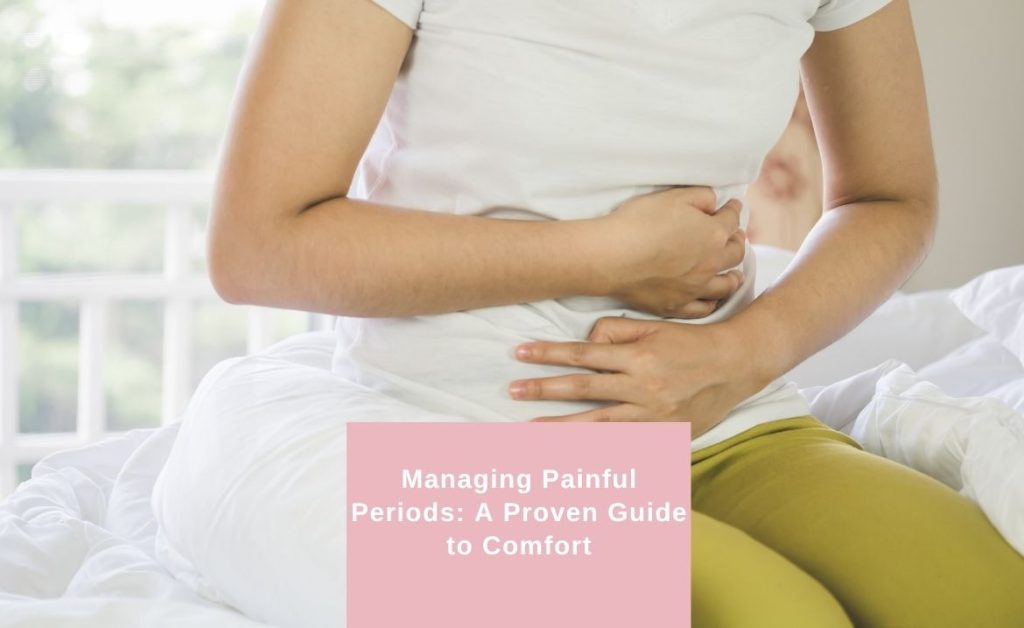For 10 to 15 women out of 100, painful periods accompany their menstrual cycle every month like an uninvited guest.
Like clockwork, you find yourself curled up in bed, clutching a hot water bottle for dear life. The familiar ache in your lower abdomen has returned, as it does every month. For countless women, painful periods are a regular part of life. A condition that is so unbearable that it can affect your day-to-day life, keeping you away from socialising and even going to work.
However, the good news is that there are ways to manage this discomfort and regain control over your body and your life.
Let’s unpack this journey together, step by step.
Understanding the Pain: What’s Happening?
For some women, the pain may feel like a deep, twisting knot, sometimes accompanied by nausea and fatigue. During the menstrual cycle, while most women may experience mild discomfort, in some cases, the pain can be so bad. The excruciating pain you feel is medically known as Dysmenorrhea. To understand what may be causing your painful periods, let’s examine the two potential areas of concern.
There are two types of Dysmenorrhea.
Primary Dysmenorrhea: occurs within the first few years of starting your period and is common in
– women who have started their period at a very young age.
– have not given birth.
– Smoke
-have a family history of Dysmenorrhea
Secondary Dysmenorrhea: You may experience painful periods if you have any of the following conditions:
– Fibroids,
– Pelvic inflammatory disease, or
Step 1: Tune into Your Body
If you have painful periods, your doctor will first check for any underlying conditions, including a family history.
To ensure you receive an accurate diagnosis, you can take a few steps:
- Recognising your pain: is the first essential step you can take.
- Keep a journal of your symptoms. Track when your cramps started, their intensity, and any accompanying headaches or bloating. This will help you identify patterns and understand your unique cycle.
- Take note of the common triggers: Some women find that stress, lack of sleep, or certain foods exacerbate their discomfort.
By tuning into your body, you can pinpoint triggers and, together with your specialist, tailor solutions that work for you.
Step 2: Lifestyle Tweaks for Long-Term Relief
Sometimes, the simplest, holistic steps can make a huge difference.
As you begin to tune into your body, we suggest you incorporate the following simple lifestyle changes.
- Exercise: While it may seem counterintuitive to move when you’re in pain, gentle activities like yoga or slow-paced walking can increase blood flow and release endorphins—your body’s natural painkillers.
- Healthy Diet: Swap fried foods and caffeine for leafy greens, fresh fruits, and omega-3-rich options like salmon and walnuts. Anti-inflammatory foods can work wonders in calming your system. As can teas like chamomile or green tea.
- Hydration: Drinking plenty of water helps ward off bloating, another unwelcome guest during your period.
These small changes may make a big difference over time, giving you a sense of empowerment.
Step 3: Quick Fixes for Immediate Comfort
Despite all your best efforts, or when you think you’ve overcome it, the pain will creep up on you unknowingly. The truth is, you may still face some tough days. That’s when leaning on a few trusty remedies for instant relief comes to the rescue.
- Heat Therapy: A heating pad or hot water bottle becomes your best friend, soothing cramps and relaxing tense muscles.
- Over-the-Counter Medications: Nonsteroidal anti-inflammatory drugs (NSAIDs), such as ibuprofen, help reduce pain and inflammation.
- Essential Oils: Massaging your abdomen with lavender oil may provide gentle relief and a calming aroma.
- Embrace self-care: prioritising activities that nourish your mind and body, such as reading, meditating, and spending time with loved ones. Managing painful periods isn’t just about the physical; it’s also about fostering emotional resilience.
Step 4: Building a Community
Knowing you’re not alone in this journey can give you a sense of support and hope. By joining a group or platform where women share tips and experiences about managing period pain, you can feel comforted in knowing you’re not alone. Sometimes, the best medicine is shared empathy and understanding.
The Path Forward
If painful periods are a part of your story, remember there’s hope, there’s help, and there’s a community ready to walk this path beside you. As discussed above, you can discover what works for you and take steps toward comfort and balance. You’re stronger than you think, and every step forward is worth celebrating.
If your period pain disrupts your life or worsens over time, don’t hesitate to seek medical advice. Sometimes, prescription medications, hormonal treatments, or even surgery might be the answer. Remember, asking for help is a sign of strength, not weakness.
Contact our team today. Dr Kothari will listen to you, answer any questions you may have and discuss your treatment options.

